Rob Gonda Podcast Transcript
Rob Gonda joins host Brian Thomas on The Digital Executive Podcast.
Welcome to Coruzant Technologies, Home of The Digital Executive podcast.
Brian Thomas: Welcome to The Digital Executive. Today’s guest is Rob Gonda. Rob Gonda is a sought-after business and technology leader and CEO of DVX, driving exponential value creation through data driven solutions. Rob is a serial entrepreneur and intrapreneur with multiple exits and has led three digital transformations at privately held, private equity backed and public portion companies, among others at McDonald’s, where he was chief digital and data officer during his leadership, the company tripled their market cap.
As a global executive with proven success, leading innovation growth and transformation in companies ranging from startups to fortune 100, he focused on digital transformation, impact of technology and shifting consumer behavior and brings an entrepreneurial management style to corporations, driving business outcome through business modeling, product, innovation, technology, modernization, and process re-engineering.
Well, good afternoon, Rob. Welcome to the show!
Rob Gonda: Hey, Brian, thanks for having me.
Brian Thomas: Absolutely love doing this. Jumping out of bed every day to do a podcast is my ultimate dream and passion. So, thank you for jumping on.
And Rob, jumping into your first question here, you’ve led multiple digital transformations at major companies, including McDonald’s. Can you share the key strategies and challenges in driving such large-scale transformations? And how do you measure success in these initiatives?
Rob Gonda: That’s a phenomenal question. It is. All transformations nowadays are driven by some type of technological disruption. Yet at the end of the day, the greatest challenge is and always will be people.
Every transformation needs to transform businesses, capabilities, process technologies, and it’s to be honest, it’s easy to rewire tech. The harder thing is to rewire people. When you think of transformations, you really have to focus about inspiring individuals, training them, reorganizing, focus and change management, and ultimately you measure it by set business goals.
It’s easy to find self-metrics, but the transformation, for instance, with. Triggered by reimagining the brands interaction with their consumer and reimagining consumer engagement. Then you have to measure the engagement metrics. If it was triggered by efficiencies, then, I mean, unfortunately, you have to imagine you have to measure it by department optimization and job reductions and ultimately it’s all about business.
So, since you mentioned McDonald’s, the transformation at the end of the day was measured and the business impact and the revenue on the stock price. And during the transformation, we managed to move the stock from 70 to over 3. So, we 4x the market cap of the company during that time.
Brian Thomas: That’s amazing. And you highlighted something that I think is key here. Obviously, you can rewire your technology, but it’s a lot harder to do that with your human capital or the people. But your people are your greatest asset as far as being part of an innovation process. So, I appreciate you highlighting that. And Rob, at DVX, you focus on generating exponential value through data driven solutions.
What are some of the most impactful data driven strategies you’ve implemented and how do they contribute to business growth and innovation?
Rob Gonda: Well, the key is to understand that data has an intrinsic value. Data powers a bunch of businesses, it powers your business, your capabilities, but the same data could have value outside your core competencies.
And most businesses are not really set up to trade in that key asset. The easiest way to explain that is actually lately, since last year, with the explosion of AI. AI trains on data. Everybody knows that AI needs data, it eats data, and it maybe it’s not widely known, but most of the public models out there, whether it’s Mitropik or Chachapiti, OpenAI, Facebook, Microsoft, they pretty much already consume all the public data that they can.
So, the differentiating part now is How do you get permission and proprietary data? Now, imagine for a second that data trade is a commodity. Data is the new oil. We’ve been hearing that since 2013. It couldn’t be truer now than ever. You can trade the barrel of oil right now for about 70 a barrel. And the same oil can be developed into, let’s say, NASCAR racing fuel, and that fuel is traded for 1, 000 a barrel.
There’s almost a 20x differential on the value of raw material and developed material. Data is the exact same way. So, what we do at DTX is that we try to identify new uses of data or data sitting dormant or underutilized within one business can drive exponential value to different business. You ask for examples.
Let me give you, most of the examples are confidential, but let me give you an example that everybody can relate to. I don’t know if you know the insurance industry covers a whole bunch of tragedy and it’s a massive industry in the US alone. We spend over a trillion dollars a year on insurance. Now, there’s significant amount of insurance fraud as you can imagine.
Worker comps and disability insurance fraud is over 40 billion dollars a year. What if the insurance industry had enough intelligence to identify whether a claim is legitimate or fraudulent? The reality is a question can be asked in this case, can be asked in any case. Is the intelligence that I need available?
Is it available within my company? Is it available somewhere else? If it’s somewhere else, how can I get access to that intelligence? The data required to answer that question exists. And without opening a can of worms, I mean, we’ve heard that. You are the product, your personal data is available elsewhere, and ultimately on a fair business value exchange, you’re trading your personal data tons or hundreds of thousands of services in exchange for free services that data can be utilized to identify activities, lifestyles, and so on that can answer certain questions.
So, what we do with the access that we help companies are sitting in high valuable data. Create net new revenue by commercializing and monetizing the data and providing data products or intelligence for other non-competing industries, whether the industry is supply chain, the industry is politics, the industry is insurance, but each 1 of this industry is looking for either revenue or cost optimization.
And in many cases, the intelligence required to achieve said business goals can come from simply getting access to process data that they currently don’t have access to. So, we package everything, we provide intelligence as a service, driving immediate results, immediate returns, immediate business impact, and driving value across the entire value chain.
Brian Thomas: Thank you, Rob. I love how you break some of those out with some examples or analogies like oil, for example, was, was a great analogy for explaining exactly how you can extract gold essentially out of data. So, I appreciate that. And Rob, how do you see technology driving changes in consumer behavior? And what steps should companies take to stay ahead of these trends? And meet evolving customer expectations.
Rob Gonda: Wow. Love it. Yet another loaded question. And to be honest, there are hundreds of examples, but since I mentioned AI in this last one, we’re going to stick to AI for now. Unless you’re living under a rock. You’ve seen the mass impact of AI driven by OpenAI and ChatGPT climbing to be the fastest growing application last year in history.
AI is completely reimagining the interaction between people and information. We’re moving from searching for answers to asking for answers, and our AI agents are just taking the burden, taking the task to compiling and browsing and going through our question and understanding context. And helping us come up to the right answer that we need, whether it’s researching products and services to generating data to with Gen AI compiling and generating charts, information, graphics, and so on.
The next shift after the information revolution is going to be AI is going to help us achieve or perform tasks, not just answer questions. And whenever AI starts doing that. You can also think that AI is going to take the role of decision making and a lot of the decision making that currently resides within the person.
Imagine routine purchases being fully delegated to your AI and assistant. Now, the implication of shift in decision making from people to AI is massive because for many industries, pretty much any B2C brand that markets and sells to the consumer will have to start thinking, well, what if now I’m not trying to influence a person making a purchase decision, but I’m trying to influence their AI and AI assistant making the purchase decision.
What will that mean for me? How am I going to shift my efforts to market? I’m going to shift my efforts to influence that AI. How does that change my advertising? How does that change my business and corporate relations with the big AI companies? What type of information that has to expose within algorithms to so the AI can pick my product versus any other market product out there, me over my competition.
So, companies need to really acknowledge that AI is, and will continue to be a massive disruptor. You mentioned transformation a few times, and it’s not that I’m advocating every company to go through massive transformation, but they do have to. Understand their own data. They have to understand how to expose things to integrate with AI.
They need to understand how AI makes decisions, and they need to be able to understand how to expose and influence some decisions. The same revolution that we’ve seen over and over again from. App store optimization and CEO optimization. Now, we’re going to have app marketplace and a marketplace optimization.
We’ve seen many iterations of this and companies that are following behind will get completely eradicated because the ship is coming. It should be top of mind, and they should already start thinking how AI disrupting is and will continue to disrupt their direct to consumer industry.
Brian Thomas: Thank you. You impact quite a bit there around the evolution of AI and how we could leverage that to make that transformation.
You know, I read something just I think yesterday, Rob said, believe it or not, the adoption of, for example open AI is chat GPT. There’s only 10 percent of people using it daily. But I see that shift happening pretty quickly, but it’s interesting how that stuff works, but I appreciate the share on that.
And Rob, last question of the day, you’re advised the C suite of elite corporations, such as Coca Cola and Target, what common challenges do these companies face in digital transformation? And what advice do you give them to overcome these obstacles?
Rob Gonda: Let me tell you, actually, let me piggyback on the last question, the comment that you made, and then I’ll answer your question.
All these companies and the C suite and the boards are looking at all this massive impact. They’re looking at the AI and they’re thinking, wow, things are moving so quickly. How can we ever keep up? What should we do, and everybody’s asking the questions around what does this impact our technology strategy?
How does this impact our HR strategy? How does this impact our product and market development strategy and so on? And what I always tell them is that as much as you think things are moving fast. This is the slowest that will move for the rest of your lives, because we are on an industry of exponential growth and accelerated pace.
And every year, things keep moving faster and faster and faster. The difference now is that the transformations a few years ago, even when I started over 10, 15 years ago, it used to be multiyear, very long processes, very long journeys. And those journeys are no longer effective or no longer even viable.
The reality is that when you’re done transforming, you’re going to need to transform again, if you’ve taken that long to react and to adapt. So the new goal for corporations is not transformation. The new goal for corporations is adaptability. We can measure adaptability. It’s a much longer answer. I’m happy to do a follow up with you another day.
We can measure a portion of adaptability of any organization as a metric, a hard metric that measures their ability to adapt to any external change. This has to measure technology, has to measure processes, it has to measure mindset and culture, as I mentioned earlier. So when you think of disruption, I mean, last year we had GPT, next year, God knows what’s going to happen.
And organizations need to be able to withstand all this destruction and they need to increase their portion of adaptability and the organization design for the 20th century is doomed to fail in the 21st century. If you think about it, organizations, all the biggest organizations in the world used to be designed for resilience.
They used to be designed to withstand change, not to embrace change. That’s the key thing that they need to need to start focusing on, because the reality, the only known reality today is that change is coming and change is going to come faster than you think. So you need to be able to continue to reevaluate and rethink your organizational design, your organizational structure, your human capital strategy, your skills, life cycle management.
You don’t have to think how many AI people do I have to hire at this moment to deal with all this AI revolution. What you need to start thinking is what’s going to be my skill life cycle management. What type of skills do I need to teach? What type of skills I need to hire? What type of skills I need to outsource?
What type of skills do I need to sunset? And how do I make sure that whatever comes new, whatever is next, I have the ability to react on no more than a quarter. So that’s a new challenge. That’s should be the goal. And that’s what every organization needs to be able to do to survive and to thrive in this century.
Brian Thomas: Thank you, Rob. I do appreciate that. I’m going to highlight a couple of things that I took out of your last answer. There is. Obviously, measurement of adaptability. I thought that was interesting, but also, we do need to embrace change. And I know resiliency was a thing and I think it still is, but to your point, we do need to embrace change because change is inevitable and it’s coming every single day. So, I appreciate that.
Rob Gonda: Yeah. Let me, let me just tell you one thing. Most corporations, what they have, it’s an immune system problem. Every time you introduce change within the system, your corporate antibodies come and fight it. And when I mentioned people, these corporate antibodies are 100 percent formed of people.
So, when I said earlier that transformation is a human transformation, what you need to do is to remove these antibodies. You need to change this mindset. You need to change this mindset from resilience and move it to adaptability. It’s way easier said than done. It requires redesigning everything from goals to corporate structures to incentives.
And mix up the old guard with new entrants and bring new people to change it up. But yes, you’re absolutely right. Ultimately is any company that needs to change needs to fight and needs to, it needs to kill these corporate antibodies.
Brian Thomas: Thank you again. I do appreciate that, Rob. And Rob, it was such a pleasure having you on today, And I look forward to speaking with you real soon.
Rob Gonda: No, thanks for having me. Looking forward to our next time.
Brian Thomas: Bye for now.
Rob Gonda Podcast Transcript. Listen to the audio on the guest’s podcast page.











